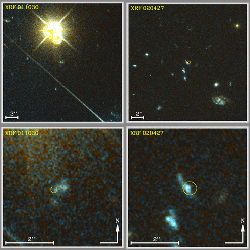September 11, 2003
CXC Press Release
RELEASE: 03-08

The galaxies (taken by HST) appear very small -- about the size of a penny view from 5 miles away -- because of their distance. The bottom panels show a close up of the galaxies with circles representing the Chandra X-ray positions of the "afterglow" light from the flashes.
(NASA/P. van Dokkum (Yale) & J. Bloom (CfA))
Astronomers using X-ray, radio, and optical telescopes have announced a big leap in solving the origin of mysterious objects known as X-ray flashes (XRFs) by finding that they originate from blue star forming galaxies. This discovery of the cosmic distance scale effectively ends the widely-held speculation that XRFs are the death-cries from stars exploding in the infant universe.
X-ray flashes resemble a lower energy and longer-duration version of a gamma-ray burst, an energetic explosion thought to signal the death of a massive star. The properties of XRFs led to speculation that they were gamma-ray bursts that occurred less than a few billion years after the Big Bang, and whose light had been subsequently weakened and time-stretched by the expansion of the universe.
"Now that the very distant origin has been ruled out, X-ray flashes could
be due to exploding massive stars, just like gamma-ray bursts" explained
Dr. Joshua Bloom at the Harvard-Smithsonian Center for Astrophysics in
Cambridge, Mass., lead author on the paper announcing the results to be
published in The Astrophysical Journal. Bloom continued: "But the explosion
from an X-ray flash would need to contain less matter or less energy than
a typical gamma-ray burst. Alternatively, X-ray flashes could be gamma-ray
bursts viewed
off-axis."
These results are being discussed at the "30th Anniversary of the Discovery of Gamma-ray Bursts" conference currently being held in Sante Fe, New Mexico.
The location of the sources studied by Bloom's group required a careful coordination of NASA's Chandra X-ray Observatory and Hubble Space Telescope, along with the National Radio Astronomy Observatory's Very Large Array (VLA) in Socorro, New Mexico. Chandra and the VLA provided a precise location of the fading X-ray and radio "afterglow" of two X-ray flashes known as XRF 011030 and XRF 020427. The Hubble Space Telescope was used to identify and study galaxies at these locations and estimate their distances to between about 6 to 11 billion light years from Earth.
X-ray flashes were discovered by John Heise (Space Research Organization, the Netherlands) and colleagues in 2001 using the Dutch-Italian X-ray satellite BeppoSAX. Bloom added the perspective that "Nearly thirty years of active research was required to discover the distance scale to gamma-ray bursts, but the distance scale mystery was solved in only two years for X-ray flashes."
The universe is particularly rich in objects that exhibit bursts at X-ray wavelengths. Bursts of X-rays are routinely detected from the Sun, from magnetically active stars, from neutron stars and black hole systems in the Milky Way, and from active supermassive black holes near the centers of distant galaxies.
"What sets X-ray flashes apart from all the other X-ray transients out there are their characteristic duration and spectrum," said Dr. Derek Fox at the California Institute of Technology, a coauthor on the paper.
X-ray flashes are relatively rare compared to other bursting sources -- with a rate of about one per day in the universe. Each flash comes without warning from a seemingly random position on the sky and lasts for tens to hundreds of seconds.
An examination of galaxies that hosted the X-ray flashes hints at a stellar origin for the explosions. "Those two galaxies in which the flashes occurred are incredibly blue," explained Prof. Pieter van Dokkum at Yale University. Since a galaxy's blueness is often taken as a crude measure of the rate of star formation, "these XRF hosts are churning out stars at an appreciable rate for their size," van Dokkum said.
The X-ray flash results were obtained through a collaborative effort with Dr. Bloom, Dr. Fox, Prof. van Dokkum, Prof. Shri Kulkarni (Caltech), Edo Berger (Caltech), Prof. George Djorgovski (Caltech), and Dr. Dale Frail (NRAO, Socorro, New Mexico).
NASA's Marshall Space Flight Center, Huntsville, Ala., manages the Chandra program for the Office of Space Science, NASA Headquarters, Washington. Northrop Grumman of Redondo Beach, Calif., formerly TRW, Inc., was the prime development contractor for the observatory. The Smithsonian Astrophysical Observatory controls science and flight operations from the Chandra X-ray Center in Cambridge, Mass.
MEDIA CONTACTS
Steve Roy
Marshall Space Flight Center, Huntsville, AL
Phone: 256-544-6535
Megan Watzke
Chandra X-ray Observatory Center, CfA, Cambridge, MA
Phone: 617-496-7998


